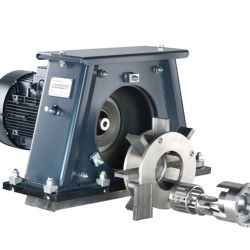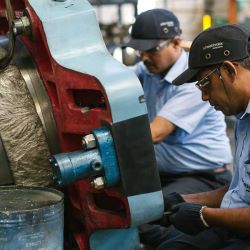The new machine had to be fitted into a very narrow - and low-ceilinged – gap within the existing production environment of this leading German automotive manufacturer; and the compact integration of abrasive logistics and workpiece handling presented particular difficulties.
The engineers from the Wheelabrator Centre for Product Innovation for Automotive Applications took on the challenge and delivered a pass-through monorail (DHB) blast machine for for the deburring of various transmission components.
Two older machines of the same type were already in operation at the site and the customer was looking to achieve a much higher production capacity with the new machine, as well as automating most of the workpiece transport and handling. The space available allowed a maximum footprint of 8m by 5m for a pitless set-up with a maximum height of 4.4m.
To achieve the desired cycle time of 43s, the power of the machine had to be trebled (compared with the existing machines). Parts are therefore transported through three blasting stations within the machine, with two 22kW blast wheels each.
Reinhard Nadicksbernd, in charge of the project at Wheelabrator Metelen, explains: “The new machine runs in three-shift operation, which means reliability and ease of maintenance were important considerations during the design phase. Also crucial was the seamless integration into the existing workpiece flow on site. And all this had to be achieved within the constraints of a tight space, avoiding important supply lines that could not be moved. Quite a tricky task for the team!”
Clean, silent, undemanding
The machine was designed specifically to drastically reduce non-productive and maintenance time. For example, it is completely encased and sealed to prevent abrasive leakage. Sluices, doors, brushes, rubber curtains and an integrated blow-off station all ensure that each and every piece of shot is captured and recycled.
The blast chamber is fully lined with manganese steel, with additional internal wear plates made from MO55E to further reduce maintenance requirements.
To ensure maximum process control, the six blast wheels feature automatic blast pattern adjustment dependent on wear and rpm.
Sound damping and vibration reduction create a relatively quiet working environment around the machine.
Automated workpiece feeder system
A complex feeder system was designed for the machine. An operator guides trolleys towards the machine, on which trays with workpieces are stacked. The system then automatically buffers and separates the trays via a gripper system and loads and unloads the blast machine automatically. Trays of varying heights can be picked up by the same gripper. After blasting, the trays are restacked onto the trolley in the correct order. If necessary, the machine can also be loaded or unloaded manually.
The new blast machine for the carmaker was fitted into its snug spot, commissioned and is in full production.


